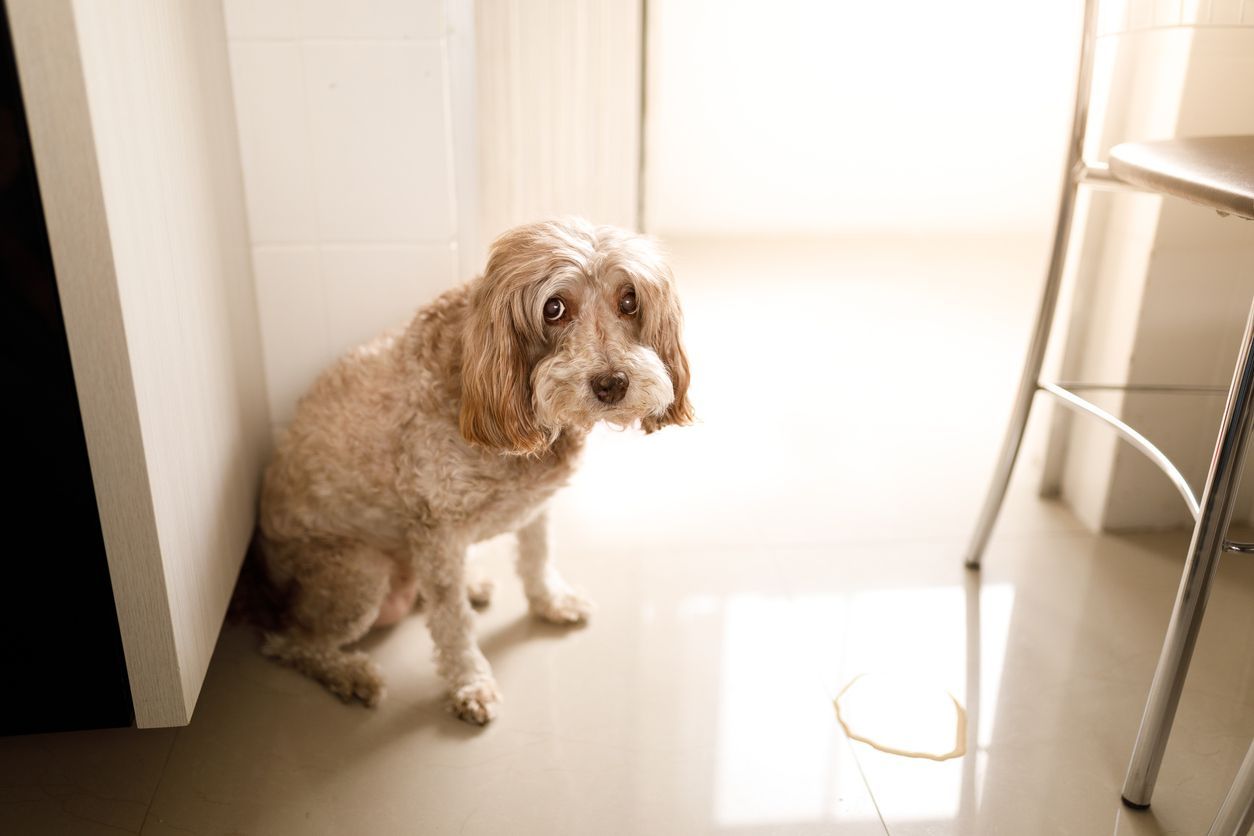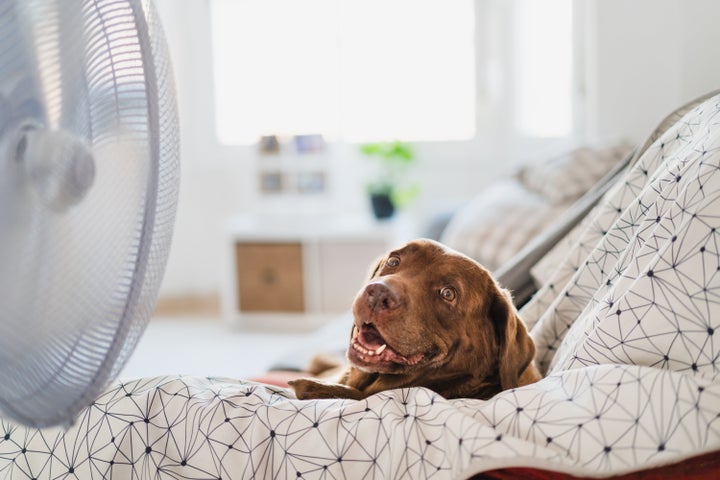To keep a dog from peeing in the house, start by tracking their behavior and using positive reinforcement. Keep your dog in the room with you and confine them when you’re not home.
Treat a puppy differently than a senior dog and determine if anxiety is the real issue. Additionally, consider getting your dog spayed or neutered and rule out any medical conditions that could be causing the behavior. Using a spray bottle with equal parts white vinegar and water can also help deter dogs from peeing on the same spot again.
Establishing a routine and providing consistent training can further prevent accidents in the house.
Understanding The Problem
To keep a dog from peeing in the house, start by establishing a routine for feeding and going outside. Use positive reinforcement and closely supervise your dog. Also, try to identify any triggers or stimuli in your dog’s environment that may be causing them to pee inside.
Why Do Dogs Pee In The House?
Understanding why dogs pee in the house is crucial in order to effectively address the issue. There can be several reasons behind this behavior, including:
- Lack of proper house-training: If your dog hasn’t been properly trained to go outside for bathroom breaks, they may resort to peeing indoors.
- Marking territory: Dogs have a natural instinct to mark their territory, and this can sometimes lead to indoor peeing.
- Separation anxiety: Dogs experiencing separation anxiety may urinate in the house as a response to stress and anxiety when left alone.
Identifying Triggers For Indoor Peeing
To effectively prevent indoor peeing, it’s important to identify the triggers that can lead to this behavior. Some common triggers include:
- Change in routine: Dogs thrive on consistency, so any sudden change in their routine, such as a new work schedule or a recent move, can cause them stress and lead to accidents inside the house.
- Lack of access to outdoor space: If your dog doesn’t have easy access to a designated potty area outside, they may be more likely to pee indoors.
- Medical issues: Certain medical conditions, such as urinary tract infections or bladder stones, can cause dogs to have accidents inside the house.
By identifying these triggers, you can take proactive steps to address the underlying causes and prevent indoor peeing in your dog. It’s recommended to consult with a veterinarian or a professional dog trainer to determine the best approach for your specific situation.

Credit: www.amazon.com
Training Methods
To maintain a clean and odor-free home, it’s essential to train your dog not to pee indoors. With the right training methods and consistency, you can successfully prevent accidents and establish a routine for your furry friend. In this section, we will explore three effective training methods that will help keep your dog from peeing in the house: Establishing a potty routine, positive reinforcement techniques, and confinement strategies.
Establishing A Potty Routine
One of the key factors in preventing your dog from peeing in the house is establishing a consistent potty routine. Dogs thrive on routine, so creating a predictable schedule will help them understand when and where they should relieve themselves.
Positive Reinforcement Techniques
Positive reinforcement is a powerful and humane training method that encourages good behavior through rewards and praise. When it comes to potty training, rewarding your dog for going outside is crucial.
Here are some positive reinforcement techniques to try:
- Immediately praise and give your dog a treat when they successfully pee outside.
- Use a specific word or phrase, such as “Go potty,” consistently before your dog goes to remind them of the desired behavior.
- Take your dog out for a longer walk or playtime as a reward after they have eliminated outside.
Confinement Strategies
Confinement strategies can be effective in preventing your dog from peeing in the house, especially when you’re not home or unable to supervise them.
Consider the following confinement strategies:
- Keep your dog in a restricted area, such as a small room or an exercise pen, when you cannot directly supervise them.
- If necessary, use a crate that is appropriately sized and comfortable for your dog. Dogs generally avoid soiling their sleeping area.
- Ensure your dog has plenty of toys, water, and a comfortable bed or blanket in their confined space.
Preventive Measures
Preventive measures for keeping a dog from peeing in the house include establishing a routine with regular feeding and go-outside schedules, positive reinforcement, and supervision. Identifying triggers or stimuli in the dog’s environment can also help eliminate unwanted behavior.
Eliminating Urine Odors
One of the main reasons dogs continue to pee in the house is because they can still smell their previous accidents. To prevent this, it’s crucial to thoroughly eliminate urine odors. Start with these steps:
- Clean accidents immediately: As soon as you discover a pee spot, blot up as much of the urine as possible with paper towels or a cloth.
- Banish stains and odors: Use an enzymatic cleaner specifically designed to break down the protein in urine. This will neutralize the odor and help prevent your dog from peeing in the same spot again. Follow the instructions on the cleaner and thoroughly treat the affected area.
- Regularly deep clean carpets and floors: Use a carpet cleaner or a steam cleaner to remove any lingering odors from your dog’s accidents. Pay extra attention to areas where your dog frequently pees.
Using Deterrent Sprays
To discourage your dog from peeing in certain areas of the house, you can use deterrent sprays that are safe for pets but have a strong scent dogs dislike. Follow these steps:
- Choose a pet-safe deterrent spray: Look for sprays that contain natural ingredients and are specifically formulated to discourage dogs from urinating in unwanted places.
- Test a small area: Before applying the deterrent spray to a larger area, test it on an inconspicuous spot to ensure it doesn’t discolor or damage the surface.
- Apply the spray: Spray the deterrent onto surfaces where your dog has previously peed or areas where you want to prevent accidents. Reapply as needed, especially after cleaning or if your dog shows interest in those spots again.
Creating A Pee-free Environment
Achieving a pee-free environment requires proactive measures and consistency. Follow these tips:
- Establish a routine: Stick to a regular feeding schedule and take your dog outside at consistent intervals. This will help them understand when and where they should relieve themselves.
- Use positive reinforcement: When your dog successfully pees outside, praise and reward them with treats immediately. This positive reinforcement will reinforce the desired behavior and encourage them to continue eliminating in the appropriate place.
- Supervise your dog: Keep a close eye on your dog, especially during transition periods or when you suspect they might have the urge to pee. This will allow you to redirect them outside before accidents happen.
- Confine your dog when necessary: If you’re unable to supervise your dog closely, confine them to a restricted area or crate where accidents are less likely to occur.
By implementing these preventive measures, you can significantly reduce the chances of your dog peeing in the house and create a clean, odor-free living environment for both you and your furry friend.

Credit: vetster.com

Credit: www.huffpost.com
Frequently Asked Questions For How To Keep A Dog From Peeing In The House
What Can I Get To Stop My Dog From Peeing In The House?
To prevent your dog from peeing in the house, try these tips:– Track your dog’s behavior and identify patterns. – Use positive reinforcement to reward desired behavior. – Keep your dog in the same room as you. – Confine your dog when you’re not home.
– Treat puppies differently than senior dogs. – Check for underlying anxiety or medical conditions.
What Scent Will Stop Dogs Peeing?
To stop dogs from peeing, mix white vinegar and water in a spray bottle and spritz it on the urinated area. The acetic acid scent repels dogs and discourages them from peeing in the same spot again.
How Do I Train A Dog Not To Pee In The House?
To train a dog not to pee in the house, establish a bathroom spot outside and consistently take the dog there. Use a specific word or phrase to remind them what to do. Reward them with a walk or playtime after they eliminate outside.
Consider using a urine stopper spray to discourage indoor marking.
What Can I Spray To Stop My Dog Peeing In The House?
To stop your dog from peeing in the house, you can try a few things: 1. Use positive reinforcement and reward them when they go outside. 2. Keep your dog in the same room as you. 3. Confine your dog when you’re not home.
4. Treat puppies differently than senior dogs. 5. Rule out any medical conditions. Consider trying a urine stopper spray that eliminates the scent and discourages re-urination.
Conclusion
Preventing a dog from peeing in the house requires consistency and positive reinforcement. Establish a routine and take your dog to the designated bathroom spot outside. Use a specific word or phrase to remind them of their bathroom behavior. Reward them with praise and treats when they eliminate outside.
Supervise your dog, confine them when you’re not home, and consider training them differently based on their age. It’s also important to rule out any medical conditions and provide a stress-free environment. Remember, patience and persistence are key in house training your furry friend.


